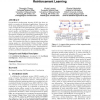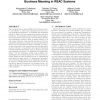792 search results - page 38 / 159 » Measuring complexity by measuring structure and organization |
BMCBI
2010
14 years 12 months ago
2010
Background: Protein-protein docking for proteins with large conformational changes was analyzed by using interaction fingerprints, one of the scales for measuring similarities amo...
100
click to vote
ATAL
2010
Springer
15 years 1 months ago
2010
Springer
Decentralized reinforcement learning (DRL) has been applied to a number of distributed applications. However, one of the main challenges faced by DRL is its convergence. Previous ...
NIPS
2007
15 years 1 months ago
2007
Much of human knowledge is organized into sophisticated systems that are often called intuitive theories. We propose that intuitive theories are mentally represented in a logical ...
109
click to vote
GECCO
2005
Springer
15 years 5 months ago
2005
Springer
This article describes a mathematical framework for characterizing cooperativity in complex systems subject to evolutionary pressures. This framework uses three foundational compo...
104
click to vote
SACMAT
2009
ACM
15 years 4 months ago
2009
ACM
The role-based access control (RBAC) model has proven to be cost effective to reduce the complexity and costs of access permission management. To maximize the advantages offered...


